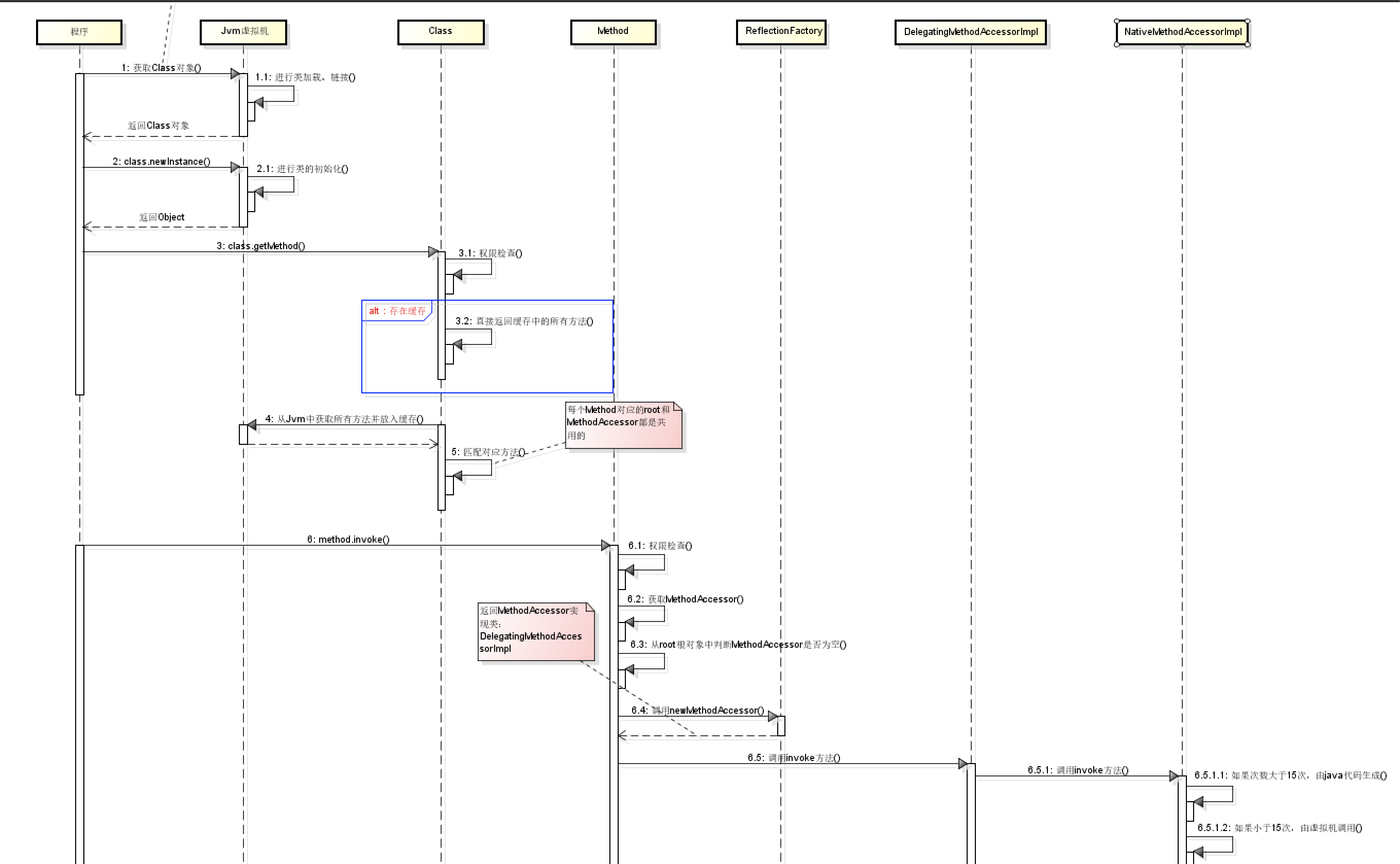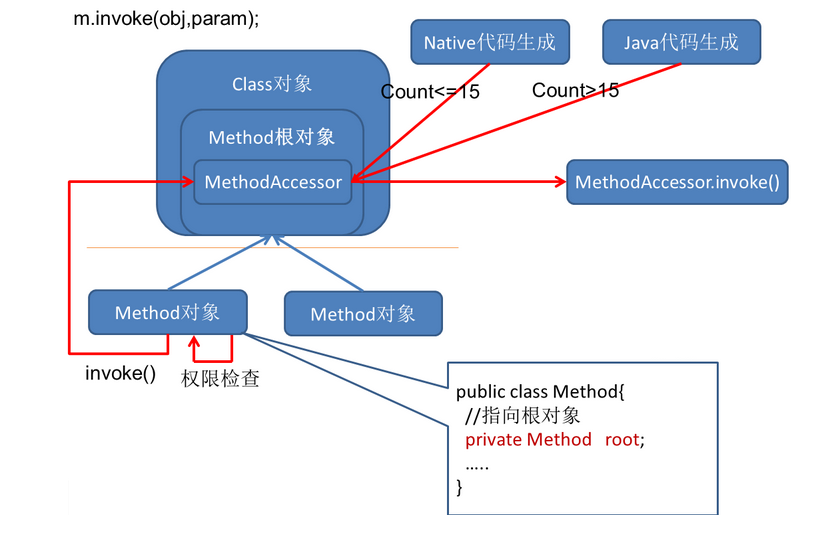参考资料:
前文:
写在开头:本文为学习后的总结,可能有不到位的地方,错误的地方,欢迎各位指正。
目录
一、反射使用实例
// person.java
public class Person {
// 其余省略...
public Person() {
System.out.println("调用默认构造函数");
}
public void sayHello(String message){
System.out.println(message);
}
}
public static void main(String[] args)
throws ClassNotFoundException, InstantiationException, IllegalAccessException, NoSuchMethodException, SecurityException, IllegalArgumentException, InvocationTargetException {
Class clazz = Class.forName("JavaTest.Person");
// 创建对象
Person p1 = (Person) clazz.newInstance();
// 获取指定参数的方法对象Method
Method method = clazz.getMethod("sayHello", String.class);
// 通过Method对象的invoke(Object obj,Object... args)方法调用
method.invoke(p1, "Hello World");
}
结果如下:
// 调用默认构造函数
// Hello World
以上实例将反射的主要使用方式进行的展示,我们将其分为三大类:
- 反射获取类实例
- 反射获取方法
- 调用 method.invoke() 方法
下面这张图将反射调用的完整流程进行了展示,下面我们来对这三个主要流程的源码进行分析,深入了解下反射的实现方式。

二、 反射获取类实例
首先进入静态方法forName的源码,这里还涉及到了类加载机制,关于类的加载在之前的文章中已经进行了介绍,这里不再赘述,有兴趣的可以先去了解下《Java8之类的加载》。在获取到类的基本信息后,调用forName0这个native方法获取该类的class信息。
@CallerSensitive
public static Class<?> forName(String className)
throws ClassNotFoundException {
// 先通过反射,获取调用进来的类信息,从而获取当前的 classLoader
Class<?> caller = Reflection.getCallerClass();
// 调用native方法进行获取class信息
return forName0(className, true, ClassLoader.getClassLoader(caller), caller);
}
接下来我们来看newInstance方法,源码较长,这里我们将其进行拆分,以便于理解。newInstance() 主要做了三件事:
(1)权限检测,如果不通过直接抛出异常。
(2)查找无参构造器,并将其缓存起来。
(3)调用具体方法的无参构造方法,生成实例并返回。
// 首先肯定是 Class.newInstance
@CallerSensitive
public T newInstance()
throws InstantiationException, IllegalAccessException
{
if (System.getSecurityManager() != null) {
checkMemberAccess(Member.PUBLIC, Reflection.getCallerClass(), false);
}
// NOTE: the following code may not be strictly correct under
// the current Java memory model.
// Constructor lookup
// newInstance() 其实相当于调用类的无参构造函数,所以,首先要找到其无参构造器
if (cachedConstructor == null) {
if (this == Class.class) {
// 不允许调用 Class 的 newInstance() 方法
throw new IllegalAccessException(
"Can not call newInstance() on the Class for java.lang.Class"
);
}
try {
// 获取无参构造器
Class<?>[] empty = {};
final Constructor<T> c = getConstructor0(empty, Member.DECLARED);
// Disable accessibility checks on the constructor
// since we have to do the security check here anyway
// (the stack depth is wrong for the Constructor's
// security check to work)
java.security.AccessController.doPrivileged(
new java.security.PrivilegedAction<Void>() {
public Void run() {
c.setAccessible(true);
return null;
}
});
cachedConstructor = c;
} catch (NoSuchMethodException e) {
throw (InstantiationException)
new InstantiationException(getName()).initCause(e);
}
}
Constructor<T> tmpConstructor = cachedConstructor;
// Security check (same as in java.lang.reflect.Constructor)
int modifiers = tmpConstructor.getModifiers();
if (!Reflection.quickCheckMemberAccess(this, modifiers)) {
Class<?> caller = Reflection.getCallerClass();
if (newInstanceCallerCache != caller) {
Reflection.ensureMemberAccess(caller, this, null, modifiers);
newInstanceCallerCache = caller;
}
}
// Run constructor
try {
// 调用无参构造器
return tmpConstructor.newInstance((Object[])null);
} catch (InvocationTargetException e) {
Unsafe.getUnsafe().throwException(e.getTargetException());
// Not reached
return null;
}
}
获取构造器的过程由getConstructor0方法完成,依然是分成三步。
(1)通过privateGetDeclaredConstructors获取所有的constructors, 然后通过进行参数类型比较;
(2)找到匹配后,通过 ReflectionFactory.copyConstructor复制一份constructor返回;
(3)如果未找到满足要求的构造方法否则抛出 NoSuchMethodException;
private Constructor<T> getConstructor0(Class<?>[] parameterTypes,
int which) throws NoSuchMethodException
{
// 获取所有构造器
Constructor<T>[] constructors = privateGetDeclaredConstructors((which == Member.PUBLIC));
for (Constructor<T> constructor : constructors) {
if (arrayContentsEq(parameterTypes,
constructor.getParameterTypes())) {
return getReflectionFactory().copyConstructor(constructor);
}
}
throw new NoSuchMethodException(getName() + ".<init>" + argumentTypesToString(parameterTypes));
}
privateGetDeclaredConstructors()方法获取所有的构造器主要步骤;
(1)先尝试从缓存中获取。
(2)如果缓存没有,则从jvm中重新获取,并存入缓存,缓存使用软引用进行保存,保证内存可用。
// 通过jvm或者缓存获取当前类所有的构造方法
private Constructor<T>[] privateGetDeclaredConstructors(boolean publicOnly) {
checkInitted();
Constructor<T>[] res;
// 调用 reflectionData(), 获取保存的信息,使用软引用保存,从而使内存不够可以回收
ReflectionData<T> rd = reflectionData();
if (rd != null) {
res = publicOnly ? rd.publicConstructors : rd.declaredConstructors;
// 存在缓存,则直接返回
if (res != null) return res;
}
// No cached value available; request value from VM
if (isInterface()) {
@SuppressWarnings("unchecked")
Constructor<T>[] temporaryRes = (Constructor<T>[]) new Constructor<?>[0];
res = temporaryRes;
} else {
// 使用native方法从jvm获取构造器
res = getDeclaredConstructors0(publicOnly);
}
if (rd != null) {
// 最后,将从jvm中读取的内容,存入缓存
if (publicOnly) {
rd.publicConstructors = res;
} else {
rd.declaredConstructors = res;
}
}
return res;
}这里getDeclaredConstructors0为native方法,有兴趣的可以了解一下,这里暂不介绍。我们看一下获取缓存的方式,即下面这行。
// 调用 reflectionData(), 获取保存的信息,使用软引用保存,从而使内存不够可以回收
ReflectionData<T> rd = reflectionData();我们可以看到ReflectionData为class类的静态内部类,专门用来存放类的信息,可以存放的变量包括field、method、constructor等。
// reflection data that might get invalidated when JVM TI RedefineClasses() is called
private static class ReflectionData<T> {
volatile Field[] declaredFields;
volatile Field[] publicFields;
volatile Method[] declaredMethods;
volatile Method[] publicMethods;
volatile Constructor<T>[] declaredConstructors;
volatile Constructor<T>[] publicConstructors;
// Intermediate results for getFields and getMethods
volatile Field[] declaredPublicFields;
volatile Method[] declaredPublicMethods;
volatile Class<?>[] interfaces;
// Value of classRedefinedCount when we created this ReflectionData instance
final int redefinedCount;
ReflectionData(int redefinedCount) {
this.redefinedCount = redefinedCount;
}
}
再看reflectionData()方法,
// 使用软引用类型,从而使内存不够可以回收
private volatile transient SoftReference<ReflectionData<T>> reflectionData;
// Lazily create and cache ReflectionData
private ReflectionData<T> reflectionData() {
SoftReference<ReflectionData<T>> reflectionData = this.reflectionData;
int classRedefinedCount = this.classRedefinedCount;
ReflectionData<T> rd;
if (useCaches &&
reflectionData != null &&
(rd = reflectionData.get()) != null &&
rd.redefinedCount == classRedefinedCount) {
return rd;
}
// 如果没有查找到缓存信息,则新建一个缓存,保存反射信息
return newReflectionData(reflectionData, classRedefinedCount);
}
如果没有查找到缓存信息,则调用newReflectionData方法新建一个缓存,保存反射信息。
private ReflectionData<T> newReflectionData(SoftReference<ReflectionData<T>> oldReflectionData,
int classRedefinedCount) {
if (!useCaches) return null;
// 使用cas保证更新的线程安全性,所以反射是保证线程安全的
while (true) {
ReflectionData<T> rd = new ReflectionData<>(classRedefinedCount);
// try to CAS it...
if (Atomic.casReflectionData(this, oldReflectionData, new SoftReference<>(rd))) {
return rd;
}
// 先使用CAS更新,如果更新成功,则立即返回,否则测查当前已被其他线程更新的情况,如果和自己想要更新的状态一致,则也算是成功了
oldReflectionData = this.reflectionData;
classRedefinedCount = this.classRedefinedCount;
if (oldReflectionData != null &&
(rd = oldReflectionData.get()) != null &&
rd.redefinedCount == classRedefinedCount) {
return rd;
}
}
}到目前为止,我们在第一步中获取所有构造方法的任务已经完成,下面需要去遍历这些构造方法,找到最匹配的那一个(这里不用担心匹配到多个问题,因为构造方法必然只有一个)。
匹配方法由arrayContentsEq完成,我们可以看到,其内部是逐个比较构造方法的参数来实现的。
private static boolean arrayContentsEq(Object[] a1, Object[] a2) {
if (a1 == null) {
return a2 == null || a2.length == 0;
}
if (a2 == null) {
return a1.length == 0;
}
if (a1.length != a2.length) {
return false;
}
for (int i = 0; i < a1.length; i++) {
if (a1[i] != a2[i]) {
return false;
}
}
return true;
}我们发现,在找到了构造方法后,并没有进行返回,而是进行了复制,这里我们也深入进去看一下流程。
// class.java
getReflectionFactory().copyConstructor(constructor)
// ReflectionFactory.java
public <T> Constructor<T> copyConstructor(Constructor<T> var1) {
return langReflectAccess().copyConstructor(var1);
}
// ReflectAccess.java
public <T> Constructor<T> copyConstructor(Constructor<T> arg) {
return arg.copy();
}
// Constructor.java
// 将找到的构造方法复制出来,而不是使用原来的实例,从而保证数据隔离
Constructor<T> copy() {
if (this.root != null)
throw new IllegalArgumentException("Can not copy a non-root Constructor");
Constructor<T> res = new Constructor<>(clazz,
parameterTypes,
exceptionTypes, modifiers, slot,
signature,
annotations,
parameterAnnotations);
// root 指向当前 constructor
res.root = this;
// Might as well eagerly propagate this if already present
res.constructorAccessor = constructorAccessor;
return res;
}
至此,我们newInstance方法的流程便基本走完了。
三、反射获取方法
getMethod方法可以分为以下几步:
(1)权限检查。
(2)调用getMethod0方法获取对应的方法
// java.lang.Class
@CallerSensitive
public Method getMethod(String name, Class<?>... parameterTypes)
throws NoSuchMethodException, SecurityException {
checkMemberAccess(Member.PUBLIC, Reflection.getCallerClass(), true);
Method method = getMethod0(name, parameterTypes, true);
if (method == null) {
throw new NoSuchMethodException(getName() + "." + name + argumentTypesToString(parameterTypes));
}
return method;
}
getMethod0方法内部调用了privateGetMethodRecursive方法,递归获得这个类的所有 public 修饰的方法(包含父类)。
private Method getMethod0(String name, Class<?>[] parameterTypes, boolean includeStaticMethods) {
MethodArray interfaceCandidates = new MethodArray(2);
Method res = privateGetMethodRecursive(name, parameterTypes, includeStaticMethods, interfaceCandidates);
if (res != null)
return res;
// Not found on class or superclass directly
interfaceCandidates.removeLessSpecifics();
return interfaceCandidates.getFirst(); // may be null
} private Method privateGetMethodRecursive(String name,
Class<?>[] parameterTypes,
boolean includeStaticMethods,
MethodArray allInterfaceCandidates) {
// Must _not_ return root methods
Method res;
// Search declared public methods
// 搜索所有的公共方法
if ((res = searchMethods(privateGetDeclaredMethods(true),
name,
parameterTypes)) != null) {
if (includeStaticMethods || !Modifier.isStatic(res.getModifiers()))
return res;
}
// Search superclass's methods
// 递归查找父类中的方法
if (!isInterface()) {
Class<? super T> c = getSuperclass();
if (c != null) {
if ((res = c.getMethod0(name, parameterTypes, true)) != null) {
return res;
}
}
}
// Search superinterfaces' methods
Class<?>[] interfaces = getInterfaces();
for (Class<?> c : interfaces)
if ((res = c.getMethod0(name, parameterTypes, false)) != null)
allInterfaceCandidates.add(res);
// Not found
return null;
}searchMethods(privateGetDeclaredMethods(true),name,parameterTypes)这个步骤在getDeclaredMethod方法中也有被利用到,可以推断出,这就是查找方法的核心逻辑。
@CallerSensitive
public Method getDeclaredMethod(String name, Class<?>... parameterTypes)
throws NoSuchMethodException, SecurityException {
checkMemberAccess(Member.DECLARED, Reflection.getCallerClass(), true);
Method method = searchMethods(privateGetDeclaredMethods(false), name, parameterTypes);
if (method == null) {
throw new NoSuchMethodException(getName() + "." + name + argumentTypesToString(parameterTypes));
}
return method;
}这里和获取构造方法的逻辑类似,都是先从缓存中获取方法,如果没有,则从jvm中获取。 不同的是,这里在调用完getDeclaredMethods0这个native方法后需要使用Reflection.filterMethods过滤出所需要的方法。
private Method[] privateGetDeclaredMethods(boolean publicOnly) {
checkInitted();
Method[] res;
ReflectionData<T> rd = reflectionData();
if (rd != null) {
res = publicOnly ? rd.declaredPublicMethods : rd.declaredMethods;
if (res != null) return res;
}
// No cached value available; request value from VM
res = Reflection.filterMethods(this, getDeclaredMethods0(publicOnly));
if (rd != null) {
if (publicOnly) {
rd.declaredPublicMethods = res;
} else {
rd.declaredMethods = res;
}
}
return res;
}
// Reflection.java
public static Method[] filterMethods(Class<?> containingClass, Method[] methods) {
if (methodFilterMap == null) {
// Bootstrapping
return methods;
}
return (Method[])filter(methods, methodFilterMap.get(containingClass));
}
// 可以过滤指定的方法,一般为空,如果要指定过滤,可以调用 registerMethodsToFilter(), 或者...
private static Member[] filter(Member[] members, String[] filteredNames) {
if ((filteredNames == null) || (members.length == 0)) {
return members;
}
int numNewMembers = 0;
for (Member member : members) {
boolean shouldSkip = false;
for (String filteredName : filteredNames) {
if (member.getName() == filteredName) {
shouldSkip = true;
break;
}
}
if (!shouldSkip) {
++numNewMembers;
}
}
Member[] newMembers =
(Member[])Array.newInstance(members[0].getClass(), numNewMembers);
int destIdx = 0;
for (Member member : members) {
boolean shouldSkip = false;
for (String filteredName : filteredNames) {
if (member.getName() == filteredName) {
shouldSkip = true;
break;
}
}
if (!shouldSkip) {
newMembers[destIdx++] = member;
}
}
return newMembers;
}再来看search方法,其内部就是具体的匹配逻辑。先是匹配方法名,然后匹配参数类型,再获取到满足这两个条件的方法后并不会立即退出,而是会继续进一步匹配返回类型,这么做,是为了获取到最精确的匹配。最后,还是通过copyMethod复制一份新的方法后返回。
private static Method searchMethods(Method[] methods,
String name,
Class<?>[] parameterTypes)
{
Method res = null;
// 使用常量池,避免重复创建String
String internedName = name.intern();
for (int i = 0; i < methods.length; i++) {
Method m = methods[i];
if (m.getName() == internedName
&& arrayContentsEq(parameterTypes, m.getParameterTypes())
&& (res == null
|| res.getReturnType().isAssignableFrom(m.getReturnType())))
res = m;
}
return (res == null ? res : getReflectionFactory().copyMethod(res));
}四、method.invoke()
可以看到核心逻辑载于获取到MethodAccessor对象来调用invoke方法。MethodAccessor是个接口,在第一次时调用 acquireMethodAccessor()创建其子类实现。
@CallerSensitive
public Object invoke(Object obj, Object... args)
throws IllegalAccessException, IllegalArgumentException,
InvocationTargetException
{
if (!override) {
if (!Reflection.quickCheckMemberAccess(clazz, modifiers)) {
Class<?> caller = Reflection.getCallerClass();
checkAccess(caller, clazz, obj, modifiers);
}
}
MethodAccessor ma = methodAccessor; // read volatile
if (ma == null) {
ma = acquireMethodAccessor();
}
return ma.invoke(obj, args);
}
同样的,会根据是否在缓存中,选择是获取缓存还是重新创建。
// probably make the implementation more scalable.
private MethodAccessor acquireMethodAccessor() {
// First check to see if one has been created yet, and take it
// if so
MethodAccessor tmp = null;
if (root != null) tmp = root.getMethodAccessor();
if (tmp != null) {
// 存在缓存时,存入 methodAccessor,否则调用 ReflectionFactory 创建新的 MethodAccessor
methodAccessor = tmp;
} else {
// Otherwise fabricate one and propagate it up to the root
tmp = reflectionFactory.newMethodAccessor(this);
setMethodAccessor(tmp);
}
return tmp;
}这里可以看到,一共有三种 MethodAccessor。MethodAccessorImpl,NativeMethodAccessorImpl,DelegatingMethodAccessorImpl。采用哪种 MethodAccessor 根据 noInflation 进行判断noInflation以及isVMAnonymousClass判断,noInflation属性默认为false,可以通过在启动命令里加上-Dsun.reflect.noInflation=true来修改,isVMAnonymousClass方法检查 method.getDeclaringClass 是否是一个虚拟机匿名的类(指被 sun.misc.Unsafe类的defineAnonymousClass方法定义)。
public MethodAccessor newMethodAccessor(Method method) {
checkInitted();
if (noInflation && !ReflectUtil.isVMAnonymousClass(method.getDeclaringClass())) {
// 生成的是 MethodAccessorImpl
return new MethodAccessorGenerator().
generateMethod(method.getDeclaringClass(),
method.getName(),
method.getParameterTypes(),
method.getReturnType(),
method.getExceptionTypes(),
method.getModifiers());
} else {
NativeMethodAccessorImpl acc =
new NativeMethodAccessorImpl(method);
DelegatingMethodAccessorImpl res =
new DelegatingMethodAccessorImpl(acc);
acc.setParent(res);
return res;
}
}我们先来看看NativeMethodAccessorImpl和DelegatingMethodAccessorImpl。
class DelegatingMethodAccessorImpl extends MethodAccessorImpl {
private MethodAccessorImpl delegate;
DelegatingMethodAccessorImpl(MethodAccessorImpl delegate) {
setDelegate(delegate);
}
public Object invoke(Object obj, Object[] args)
throws IllegalArgumentException, InvocationTargetException
{
return delegate.invoke(obj, args);
}
void setDelegate(MethodAccessorImpl delegate) {
this.delegate = delegate;
}
}class NativeMethodAccessorImpl extends MethodAccessorImpl {
private final Method method;
private DelegatingMethodAccessorImpl parent;
private int numInvocations;
NativeMethodAccessorImpl(Method method) {
this.method = method;
}
public Object invoke(Object obj, Object[] args)
throws IllegalArgumentException, InvocationTargetException
{
// We can't inflate methods belonging to vm-anonymous classes because
// that kind of class can't be referred to by name, hence can't be
// found from the generated bytecode.
if (++numInvocations > ReflectionFactory.inflationThreshold()
&& !ReflectUtil.isVMAnonymousClass(method.getDeclaringClass())) {
MethodAccessorImpl acc = (MethodAccessorImpl)
new MethodAccessorGenerator().
generateMethod(method.getDeclaringClass(),
method.getName(),
method.getParameterTypes(),
method.getReturnType(),
method.getExceptionTypes(),
method.getModifiers());
parent.setDelegate(acc);
}
return invoke0(method, obj, args);
}
void setParent(DelegatingMethodAccessorImpl parent) {
this.parent = parent;
}
private static native Object invoke0(Method m, Object obj, Object[] args);
}结合上面三块代码,我们可以整理出一条调用链,当调用ma.invoke时,会调用 DelegatingMethodAccessorImpl.invoke(),但内部又会被委托到 NativeMethodAccessorImpl.invoke(),进而调用invoke0这个native方法。
不过我们可以看到,在NativeMethodAccessorImpl.invoke()方法内部,还存在着一段逻辑,和前文中newMethodAccessor方法类似。
// newMethodAccessor方法
if (noInflation && !ReflectUtil.isVMAnonymousClass(method.getDeclaringClass())) {
// 生成的是 MethodAccessorImpl
return new MethodAccessorGenerator().
generateMethod(method.getDeclaringClass(),
method.getName(),
method.getParameterTypes(),
method.getReturnType(),
method.getExceptionTypes(),
method.getModifiers());
}
// NativeMethodAccessorImpl.invoke
if (++numInvocations > ReflectionFactory.inflationThreshold()
&& !ReflectUtil.isVMAnonymousClass(method.getDeclaringClass())) {
MethodAccessorImpl acc = (MethodAccessorImpl)
new MethodAccessorGenerator().
generateMethod(method.getDeclaringClass(),
method.getName(),
method.getParameterTypes(),
method.getReturnType(),
method.getExceptionTypes(),
method.getModifiers());
parent.setDelegate(acc);
}
这里就需要介绍一下反射中的Inflation机制:如果该方法的累计调用次数<=15,会调用NativeMethodAccessorImpl的native方法实现反射;如果该方法的累计调用次数>15,会由java代码创建出字节码组装而成的MethodAccessorImpl。
前文中我们介绍的noInflatio就是将其关闭的指令,不过默认情况下都是开启状态。numInvocations是统计反射调用次数的变量,其与ReflectionFactory.inflationThreshold()中的inflationThreshold变量比较,默认为15次(可以通过 -Dsun.reflect.inflationThreshold 来调整)。也就是说,当该方法调用次数大于15次时,会调用MethodAccessorGenerator的
generateMethod方法动态生成MethodAccessorImpl类的字节码。

这种设计的原因在于,动态实现和本地实现相比,其运行效率要快上 20 倍。这是因为动态实现无需经过 Java 到 C++ 再到 Java 的切换,但由于生成字节码十分耗时,仅调用一次的话,反而是本地实现要快上 3 到 4 倍。
最后再来看一下生成方法generate()的内部一些需要关注的点。
/** This routine is not thread-safe */
private MagicAccessorImpl generate(final Class<?> declaringClass,
String name,
Class<?>[] parameterTypes,
Class<?> returnType,
Class<?>[] checkedExceptions,
int modifiers,
boolean isConstructor,
boolean forSerialization,
Class<?> serializationTargetClass)
{
// 其余省略
return AccessController.doPrivileged(
new PrivilegedAction<MagicAccessorImpl>() {
public MagicAccessorImpl run() {
try {
return (MagicAccessorImpl)
ClassDefiner.defineClass
(generatedName,
bytes,
0,
bytes.length,
declaringClass.getClassLoader()).newInstance();
} catch (InstantiationException | IllegalAccessException e) {
throw new InternalError(e);
}
}
});
}
主要看这一句:ClassDefiner.defineClass(xx, declaringClass.getClassLoader()).newInstance();
在ClassDefiner.defineClass方法实现中,每被调用一次都会生成一个DelegatingClassLoader类加载器对象 ,这里每次都生成新的类加载器,是为了性能考虑,在某些情况下可以卸载这些生成的类,因为类的卸载是只有在类加载器可以被回收的情况下才会被回收的,如果用了原来的类加载器,那可能导致这些新创建的类一直无法被卸载。






















 1821
1821











 被折叠的 条评论
为什么被折叠?
被折叠的 条评论
为什么被折叠?








